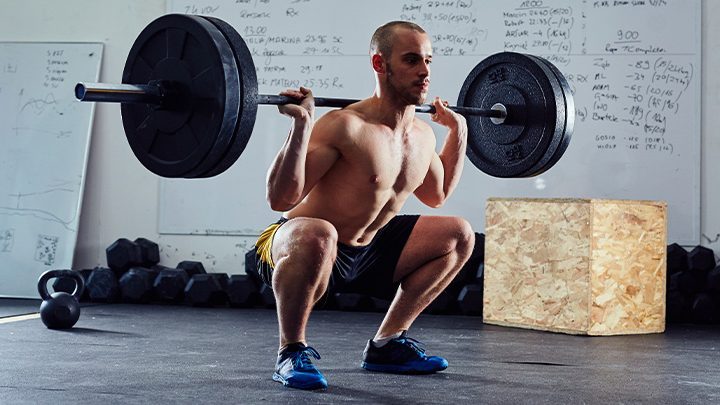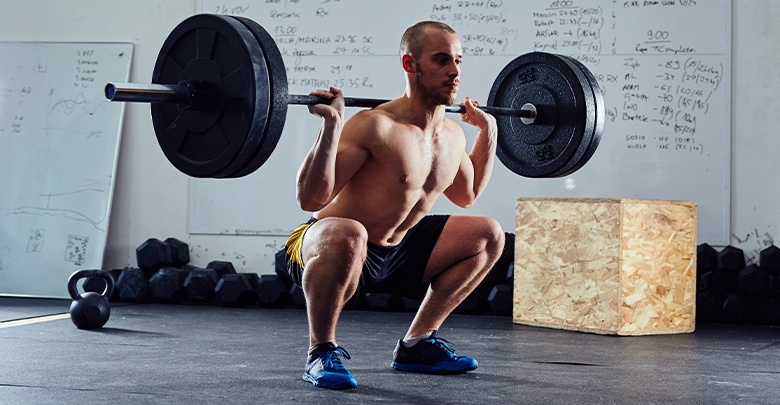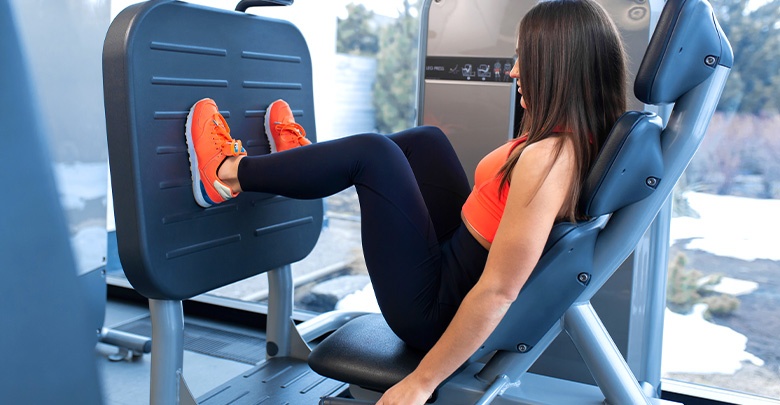
Have you been told you should strengthen your knee muscles, after tearing your meniscus? Do you have a clear guideline in terms of torn meniscus exercises? Have you considered that you may make your knee worse by unknowingly doing something damaging? What exercises should you in fact not do, following a knee meniscus injury? Below are physiotherapy-approved guidelines, to ensure that in the process of strengthening your knee, you do not do yourself more harm than good! We discuss the 4 exercises you should never do following a meniscal injury, OhMy.Health also offer you the safer options – with plenty of tips, guidelines and free videos – to guide you through getting the most out of your strengthening and rehabilitation program.
USE the OMH exclusive code "HEALTH15" to Save 15%The “good” for torn meniscus exercise: squats
What is a normal squat?
- A squat movement involves standing on both legs, feet hip distance (or wider) apart. Then bending your knees so that your butt sinks towards the floor. Straightening up again
- These normal squat movements are fine to do following a meniscus injury, provided you are able to bear weight comfortably and do not have any pain.
- Initially you should do them without any extra weights. You want to minimise the stress and strain on your knee joint, while still strengthening your quadriceps and butt muscles
Ideal normal squat
- You can start by doing mini squats, even holding onto a chair, with just a small bend in your knees. Gradually progress how far you go down as you get stronger
- You should never go further than 90* bend of your knees
- Your knees should stay aligned with your second toe, and should not go forward past your ankle
- Your upper body should lean just slightly forward as you bend your knees
- You can check out the mini squat exercise in this video
A note about adding weights or resistance to normal squats
- If you are a sports person, athlete, gym bunny or CrossFit fan and are desperate to add weights or kettle-bells to your squats you will need to be patient and discuss your injury with your orthopaedic surgeon. The meniscus is a cartilaginous structure and does not have its own blood supply, so the tear may or may not heal, depending on where your meniscal injury is exactly,
- Initially (for the first 6-12 weeks) following a meniscal injury or surgery, it would be better to avoid adding any extra weights to a squat. This is because the extra downward force through your knee will aggravate any inflammation and potentially cause further damage to the meniscus and cartilage.
The “bad” for torn meniscus exercise: deep squats

- A deep squat is a squat movement where your knees bend further than 90* and your butt drops lower than your knee joint line.
- A deep squat is definitely to be avoided following a meniscal injury as it places excessive force on the meniscus. This can lead to further meniscal damage, aggravation of pain and swelling and an increased likelihood of developing osteoarthritis in the knee.
- You obviously would therefore not do a deep squat with added weights… ever!
- Deep squats are often the cause of meniscal injuries seen in the younger population – the gym goers, CrossFitters and power lifters of the world are unfortunately often at risk of developing meniscal injuries due to exercises involving deep squats with added weight.
The “good” for torn meniscus exercise: leg press with light weight
What is leg press
- The leg press is a machine at the gym, where you are seated or reclining back with your feet placed shoulder width (or wider apart) on a flat metal plate. The plate is connected to weights and the resistance can therefore be adjusted according to your needs. You push the plate away from you using both legs.
- Due to the fact that the resistance is distributed throughout the knee joint this exercise is much safer in general for knee patients than say leg extensions. Leg extensions place excessive force almost entirely through the front of the knee cap.

Ideal leg press
- You should keep your knees aligned with your second toe, and focus on activating your butt muscles as you initiate the push action. Squeeze your thigh muscles (quadriceps) at the end of the push. Also move slowly through the bending and straightening action.
- Adjust the seat so that you do not ever bend your knees further than 90* (right angle) when doing leg press, as it will place too much pressure on the menisci.
A note about adding weight of resistance to leg press
- Keep the resistance minimal for the first 6 – 12 weeks in order to avoid aggravating the meniscus injury.
- Never push through pain or swelling!
The “bad” for torn meniscus exercises: deep leg press with heavy weights
- Deep leg press is the same as the gym exercise described above, however the knee joint is bent further than 90* into a fully bent position
- This fully flexed position places excessive pressure on the meniscus and will cause further damage, which will most likely accelerate the early onset of osteoarthritis.
- Heavy weights plus the deep knee bending are forever a no-no for anyone with knee issues, particularly meniscus injuries.
The “good” for torn meniscus exercise: lunges

A basic lunge is where you have one foot a large stride length in front of the other, and by bending both knees you drop your back knee down towards the floor. For the average person this may be challenging enough. A lunge requires a fair amount of balance, core, glute and quad strength! For a regular gym goer this exercise would be a breeze and there are many variations on the basic lunge.
If you are new to lunges, you can safely do mini stride lunges:
- start by holding onto a chair placed to the side of you
- then simply place one foot a fair distance in front of you, with your feet in line with your hips and your knees aligned to your second toes
- now slowly bend both knees and drop your weight down into the back knee
- the front knee must NOT go further forward than your ankle joint
- neither knee should bend more than 90*, and if you are starting out, simply go to about 45* of knee bend. Over time you can gradually increase how far you go down, always following the above guidelines.
The “bad” for torn meniscus exercise: deep lunges
- Deep plunges are not good for meniscal injuries because they place too much mechanical pressure on the meniscus. This causes further injury to a structure which is notoriously difficult to heal due to its poor blood supply.
- Avoid that either knee bends further than 90* in a lunge!
- Avoid your front knee going past your ankle, and rather focus on dropping down into the back knee (which must also not bend more than 90*)
- Keep your knee cap in line with your second toe – this helps to reduce the shearing and rotational forces through your knee joint.
- If you are unable to keep your knee aligned with your second toe, or your front knee behind your ankle, then rather stick to mini squats and gradually improve your technique and strength until you can maintain good alignment
- Avoid using weights with lunging until you have perfect form (and never more than 90* knee bend in either knee) and you have the go ahead from your orthopaedic surgeon – also wait at least 12 weeks before you even consider weights!
More “good”: straight linear movements to strengthen your leg and hip muscles
- It is very important to strengthen your front thigh muscles (quadriceps); inner thigh muscles (adductors); your back thigh muscles (hamstrings) and also your very important butt muscles – the gluteus medius, minimus and maximus.
- Strengthening the muscles – particularly the quadriceps – is one of the most important factors to slow down the progression of osteoarthritis following a meniscus injury. It is also one of the only factors easily in your control.
- Initially, in the first few weeks to months following an injury you can follow this exercise video, which is designed specifically by a physio for meniscus injuries.
- These exercises avoid twisting and rotation in the knee joint and also exert minimal loading on the damaged meniscus
The “ugly”: avoid twisting, turning and pivoting on the knee joint following meniscus injury
- Meniscal injures are often sustained during activities involving twisting, pivoting movements while the foot is planted on the floor, with a bent knee.
- It is therefore logical that you should avoid these sorts of movements while exercising. Especially with added weights or resistance!
- Sporting activities such as soccer, netball, tennis, basketball and skiing (amongst others) are unfortunately all sports, which involve twisting, pivoting movements with a bent knee whilst your foot is planted on the ground. It would therefore be advisable that you discuss with your orthopaedic surgeon if and when you can return to these sports.
- Depending on where the tear is situated, some meniscal tears heal well and others do not heal at all and require surgery.
- Even if your doctor says it is okay, you should wait at least 3 months following an injury or surgery before even considering playing any sport, in order to give your body time to heal optimally
- Never ever play or train through pain or swelling. These are important cues to tell you that there is a problem with your knee.
To sum up & some more resources
Strengthening the muscles around your knee joint is critically important following a meniscal or any other knee injury. The above guidelines will help you to prevent doing any harm. Remember to check out this great exercise video for torn meniscus exercises, and you can also read more articles about meniscus injuries. The video contains great information about the meniscus anatomy too, and has all the right exercises, which you can easily do at home with no equipment, following a meniscal injury or meniscus surgery.
You can also sign up and receive the free downloadable PDF, as an easy reference for of all of the physio approved meniscal injury exercises.
Remember to listen to your body, and be kind to your joints!
References
- Brukner & Khan, Brukner & Khan’s Clinical Sports Medicine: Injuries, Voume 1. 2017
- Frank H. Netter, Atlas of Human Anatomy, International Edition, Elsevier Health Sciences, London
- Musculoskeletal Examination and Assessment – A Handbook for Therapists, 5th Edition by Nicola J. Petty, Elsevier